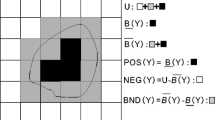Abstract
It is known that the existing \(\nu\)-twin support vector regression (\(\nu\)-TWSVR) has the ability to optimize \(\varepsilon _1\) and \(\varepsilon _2\) automatically through the proper selections of the parameters \(\nu _1\) and \(\nu _2\). However, since only the points near the lower-bound and upper-bound regressors are considered, it often results in overfitting problems. Furthermore, the equal penalties are applied to all samples that normally have different effects on the regressor function. In this paper, we propose an adaptive twin support vector regression (ATWSVR) machine to reduce the negative impacts of the possible outliers in \(\nu\)-twin support vector regression (\(\nu\)-TWSVR) by incorporating the fuzzy and rough set theories. First, two optimization models are constructed to obtain the lower and upper-bound regressors involving the use of the tools in rough and fuzzy set theories. Consequently, Theorems 1 and 2 are derived, through the application of KKT conditions and duality theory, to provide the connections between the dual optimal values and the location regions of the data points. Then, the definitions of different types of support vectors and their fuzzy proportions are given and Theorems 3 and 4 are proved to provide the bounds for the fuzzy proportions of these support vectors. Finally, the training data points located in different regions are assigned different fuzzy membership values by using iterative methods. Moreover, this approach can achieve the structural risk minimization and automatically control the fuzzy proportions of support vectors. The proposed ATWSVR is more robust for the data sets with outliers, as evidenced by the experimental results on both simulated examples as well as the benchmark real-world data sets. These results also confirm the claims made in the theorems mentioned above.









Similar content being viewed by others
References
Cortes C, Vapnik V (1995) Support vector machine. Mach Learn 20(3):273–297
Li S, Kwok JT, Zhu H (2003) Texture classification using the support vector machines. Pattern Recognit 36(12):2883–2893
Kim K (2003) Financial time series forecasting using support vector machines. Neurocomputing 55(1):307–319
Shi Y, Zhang X, Wan J (2007) Predicting the distance between antibody interface residue and antigen to recognize antigen types by support vector machine. Neural Comput Appl 16(4–5):481–490
Du XF, Leung SCH, Zhang JL (2013) Demand forecasting of perishable farm products using support vector machine. Int J Syst Sci 44(3):556–567
Smola AJ, Schölkopf B (2004) A tutorial on support vector regression. Stat Comput 14(3):199–222
Schölkopf B, Bartlett P, Smola A et al (1998) Support vector regression with automatic accuracy control. In: ICANN 98. Springer, London
Peng X (2010) TSVR: an efficient twin support vector machine for regression. Neural Netw 23(3):365–372
Tanveer M, Shubham K, Aldhaifallah M (2016) An efficient implicit regularized Lagrangian twin support vector regression. Appl Intell 44:831–848
Singh M, Chadha J, Ahuja P (2011) Reduced twin support vector regression. Neurocomputing 74(9):1474–1477
Zhang Z, Lv T, Wang H et al (2018) A novel least square twin support vector regression. Neural Process Lett 48(2):1187–1200
Xu Y, Li X, Pan X et al (2017) Asymmetric \(\nu\)-twin support vector regression. Neural Comput Appl (2):1–16
Balasundaram S, Tanveer M (2013) On Lagrangian twin support vector regression. Neural Comput Appl 22(1):257–267
Parastalooi N, Amiri A, Aliheidari P (2016) Modified twin support vector regression. Neurocomputing 211:84–97
Shao YH, Zhang CH, Yang ZM, Jing L, Deng NY (2013) An \(\varepsilon\)-twin support vector machine for regression. Neural Comput Appl 23(1):175–185
Rastogi R, Anand P, Chandra S (2017) A \(\nu\)-twin support vector machine based regression with automatic accuracy control. Appl Intell 46(3):670–683
Pawlak Z, Skowron A (2007) Rough sets and Boolean reasoning. Inf Sci 177(1):41–73
Zadeh LA (1965) Fuzzy sets. Inf Control 8(3):338–353
Klir GJ (1994) Multivalued logics versus modal logics: alternative frameworks for uncertainty modelling. Adv Fuzzy Theory Technol 2:3–47
Yeh CC, Chi DJ, Hsu MF (2010) A hybrid approach of DEA, rough set and support vector machines for business failure prediction. Expert Syst Appl 37(2):1535–1541
Zhao Y, Sun J (2009) Rough \(\nu\)-support vector regression. Expert Syst Appl 36(6):9793–9798
Xu Y, Wang L, Zhong P (2012) A rough margin-based \(\nu\)-twin support vector machine. Neural Comput Appl 21(6):1307–1317
Hong DH, Hwang C (2003) Support vector fuzzy regression machines. Fuzzy Sets Syst 138(2):271–281
Yang CY, Chou JJ, Lian FL (2013) Robust classifier learning with fuzzy class labels for large-margin support vector machines. Neurocomputing 99:1–14
Lingras P (2001) Fuzzy-rough and rough-fuzzy serial combinations in neurocomputing. Neurocomputing 36(1):29–44
Chen D, He Q, Wang X (2010) FRSVMs: fuzzy rough set based support vector machines. Fuzzy Sets Syst 161(4):596–607
He Q, Wu C (2011) Membership evaluation and feature selection for fuzzy support vector machine based on fuzzy rough sets. Soft Comput 15(6):1105–1114
Karush W (2014) Minima of functions of several variables with inequalities as side conditions. Traces and Emergence of Nonlinear Programming. Springer, Basel, pp 217–245
Blake C L, Merz C J (1998) UCI repository of machine learning databases. http://archive.ics.uci.edu/ml/index.php. Irvine, CA: University of California. Department of Information and Computer Science
Weisberg S (2005) Applied linear regression. Wiley, New York
Staudte RG, Sheather SJ (2011) Robust estimation and testing. Wiley, New York
Rodríguez-Fdez I, Canosa A, Mucientes M, Bugarín A (2015) STAC: a web platform for the comparison of algorithms using statistical tests. In: Proceedings of the 2015 IEEE International Conference on Fuzzy Systems (FUZZ-IEEE)
Acknowledgements
The authors wish to acknowledge the financial support of the National Nature Science Foundation of China (No. 61562001), High level Scientific research cultivation Foundation of Henan University of Science and Technology (No. 2015GJB010) and The Technology Plan project of Department of Education Science of Henan Province (No. 19A120005).
Author information
Authors and Affiliations
Corresponding author
Rights and permissions
About this article
Cite this article
Xue, Z., Zhang, R., Qin, C. et al. An adaptive twin support vector regression machine based on rough and fuzzy set theories. Neural Comput & Applic 32, 4709–4732 (2020). https://doi.org/10.1007/s00521-018-3823-4
Received:
Accepted:
Published:
Issue Date:
DOI: https://doi.org/10.1007/s00521-018-3823-4




